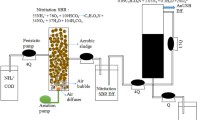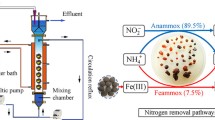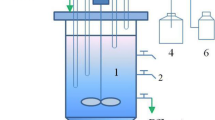Abstract
An autotrophic denitrifying bioreactor with iron sulfide (FeS) as the electron donor was operated to remove ammonium (NH4+) and nitrate (NO3−) synergistically from wastewater for more than 298 d. The concentration of FeS greatly affected the removal of NH4+/NO3−. Additionally, a low hydraulic retention time worsened the removal efficiency of NH4+/NO3−. When the hydraulic retention time was 12 h, the optimal removal was achieved with NH4+ and NO3− removal percentages both above 88%, and the corresponding nitrogen removal loading rates of NH4+ and NO3− were 49.1 and 44.0 mg/(L·d), respectively. The removal of NH4+ mainly occurred in the bottom section of the bioreactor through sulfate/ferric reducing anaerobic ammonium oxidation (Sulfammox/Feammox), nitrification, and anaerobic ammonium oxidation (Anammox) by functional microbes such as Nitrospira, Nitrosomonas, and Candidatus Kuenenia. Meanwhile, NO3− was mainly removed in the middle and upper sections of the bioreactor through autotrophic denitrification by Ferritrophicum, Thiobacillus, Rhodanobacter, and Pseudomonas, which possessed complete denitrification-related genes with high relative abundances.

Similar content being viewed by others
References
APHA (2005). Standard Methods for the Examination for Water and Wastewater, 21st ed. APHA, AWWA and WEF. Washington, DC
Cao X, Zheng H, Liao Y, Feng L, Jiang L, Liu C, Mao Y, Shen Q, Zhang Q, Ji F (2022). Effects of iron-based substrate on coupling of nitrification, aerobic denitrification and Fe(II) autotrophic denitrification in tidal flow constructed wetlands. Bioresource Technology, 361: 127657
Carboni M F, Mills S, Arriaga S, Collins G, Ijaz U Z, Lens P N L (2022). Autotrophic denitrification of nitrate rich wastewater in fluidized bed reactors using pyrite and elemental sulfur as electron donors. Environmental Technology & Innovation, 28: 102878
Cardenas E, Wu W M, Leigh M B, Carley J, Carroll S, Gentry T, Luo J, Watson D, Gu B, Ginder-Vogel M, et al. (2010). Significant association between sulfate-reducing bacteria and uranium-reducing microbial communities as revealed by a combined massively parallel sequencing-indicator species approach. Applied and Environmental Microbiology, 76(20): 6778–6786
Chan-Pacheco C R, Valenzuela E I, Cervantes F J, Quijano G (2021). Novel biotechnologies for nitrogen removal and their coupling with gas emissions abatement in wastewater treatment facilities. Science of the Total Environment, 797: 149228
Chung J, Amin K, Kim S, Yoon S, Kwon K, Bae W (2014). Autotrophic denitrification of nitrate and nitrite using thiosulfate as an electron donor. Water Research, 58: 169–178
Dominika G, Joanna M, Jacek M (2021). Sulfate reducing ammonium oxidation (SULFAMMOX) process under anaerobic conditions. Environmental Technology & Innovation, 28: 101416
Du R, Cao S, Li B, Niu M, Wang S, Peng Y (2017). Performance and microbial community analysis of a novel DEAMOX based on partial-denitrification and anammox treating ammonia and nitrate wastewaters. Water Research, 108: 46–56
Du R, Peng Y, Ji J, Shi L, Gao R, Li X (2019). Partial denitrification providing nitrite: opportunities of extending application for anammox. Environment International, 131: 105001
Feng Y, Lu X, Al-Hazmi H, Mąkinia J (2017). An overview of the strategies for the deammonification process start-up and recovery after accidental operational failures. Reviews in Environmental Science and Biotechnology, 16(3): 541–568
Fortin D, Davis B, Beveridge T J (1996). Role of Thiobacillus and sulfate-reducing bacteria in iron biocycling in oxic and acidic mine tailings. FEMS Microbiology Ecology, 21(1): 11–24
Glass C and Silverstein J, (1998). Denitrification kinetics of high nitrate concentration water: pH effect on inhibition and nitrite accumulation. Water Research, 32(3): 831–839
Hu Y, Li N, Jiang J, Xu Y, Luo X, Cao J (2022). Simultaneous Feammox and anammox process facilitated by activated carbon as an electron shuttle for autotrophic biological nitrogen removal. Frontiers of Environmental Science & Engineering, 16(7): 90
Hu Y, Wu G, Li R, Xiao L, Zhan X (2020). Iron sulphides mediated autotrophic denitrification: an emerging bioprocess for nitrate pollution mitigation and sustainable wastewater treatment. Water Research, 179: 115914
Huang S, Jaffé P R (2015). Characterization of incubation experiments and development of an enrichment culture capable of ammonium oxidation under iron-reducing conditions. Biogeosciences, 12(3): 769–779
Jin R C, Yang G F, Yu J J, Zheng P (2012). The inhibition of the Anammox process: a review. Chemical Engineering Journal, 197: 67–79
Kraft B, Jehmlich N, Larsen M, Bristow L A, Konneke M, Thamdrup B, Canfield D E (2022). Oxygen and nitrogen production by an ammonia-oxidizing archaeon. Science, 375(6576): 97–100
Li H, Su J Q, Yang X R, Zhou G W, Lassen S B, Zhu Y G (2019). RNA stable isotope probing of potential feammox population in paddy soil. Environmental Science & Technology, 53(9): 4841–4849
Li R, Morrison L, Collins G, Li A, Zhan X (2016). Simultaneous nitrate and phosphate removal from wastewater lacking organic matter through microbial oxidation of pyrrhotite coupled to nitrate reduction. Water Research, 96: 32–41
Li S H, Zhou X, Cao X W, Chen J B (2021). Insights into simultaneous anammox and denitrification system with short-term pyridine exposure: process capability, inhibition kinetics and metabolic pathways. Frontiers of Environmental Science & Engineering, 15(6): 139
Lichtenberg M, Line L, Schrameyer V, Jakobsen T H, Rybtke M L, Toyofuku M, Nomura N, Kolpen M, Tolker-Nielsen T, Kuhl M, Bjarnsholt T, Jensen P O (2021). Nitric-oxide-driven oxygen release in anoxic Pseudomonas aeruginosa. iScience, 24(12): 103404
Liu L Y, Xie G J, Xing D F, Liu B F, Ding J, Cao G L, Ren N Q (2021). Sulfate dependent ammonium oxidation: a microbial process linked nitrogen with sulfur cycle and potential application. Environmental Research, 192: 110282
Ma J, Wei J, Kong Q, Li Z, Pan J, Chen B, Qiu G, Wu H, Zhu S, Wei C (2021). Synergy between autotrophic denitrification and Anammox driven by FeS in a fluidized bed bioreactor for advanced nitrogen removal. Chemosphere, 280: 130726
Ma J D, Pan J X, Li Z M, Wang Y X, Wu H Z, Wei C H (2019). Performance and mechanisms of advanced nitrogen removal via FeS-driven autotrophic denitrification coupled with Anammox. Environmental Sciences, 40(8): 3683–3690 (in Chinese)
Mohamed N M, Saito K, Tal Y, Hill R T (2010). Diversity of aerobic and anaerobic ammonia-oxidizing bacteria in marine sponges. ISME Journal, 4(1): 38–48
Mulder A, van de Graaf A A, Robertson L A, Kuenen J G (1995). Anaerobic ammonium oxidation discovered in a denitrifying fluidized bed reactor. FEMS Microbiology Ecology, 16(3): 177–183
Wan D, Li Q, Liu Y, Xiao S, Wang H (2019). Simultaneous reduction of perchlorate and nitrate in a combined heterotrophic-sulfur-autotrophic system: secondary pollution control, pH balance and microbial community analysis. Water Research, 165: 115004
Wan L, Liu H, Wang X (2022). Anaerobic ammonium oxidation coupled to Fe(III) reduction: discovery, mechanism and application prospects in wastewater treatment. Science of the Total Environment, 818: 151687
Wang Y, Wu G, Zheng X, Mao W, Guan Y (2022). Synergistic ammonia and nitrate removal in a novel pyrite-driven autotrophic denitrification biofilter. Bioresource Technology, 355: 127223
Xin Y, Liu L, Wei L, Huang X, Liu C (2021). Recycling of rural abandoned constructed wetlands: mariculture wastewater treatment. Journal of Water Reuse and Desalination, 11(2): 279–288
Yang Y, Chen T, Morrison L, Gerrity S, Collins G, Porca E, Li R, Zhan X (2017). Nanostructured pyrrhotite supports autotrophic denitrification for simultaneous nitrogen and phosphorus removal from secondary effluents. Chemical Engineering Journal, 328: 511–518
Zhang T, Feng Z, Shi Y, Yin Q, Wu G (2022). Ammonium removal and potential microbial interactions under oxygen-Limited conditions. Journal of Environmental Engineering, 148(4): 04022008
Zhu B, Wang J, Bradford L M, Ettwig K, Hu B, Lueders T (2019a). Nitric oxide dismutase (nod) genes as a functional marker for the diversity and phylogeny of methane-driven oxygenic denitrifiers. Frontiers in Microbiology, 10: 1577
Zhu T, Cheng H, Yang L, Su S, Wang H, Wang S, Wang A (2019b). Coupled sulfur and iron(II) carbonate-driven autotrophic denitrification for significantly enhanced nitrate removal. Environmental Science & Technology, 53(3): 1545–1554
Acknowledgements
This study was supported by the Guangxi Key R & D Program (No. 2021AB25056), and the Shenzhen Key Scientific and Technological Project (No. JSGG20191129094410446).
Author information
Authors and Affiliations
Corresponding author
Additional information
Highlights
• Simultaneous NH4+/NO3− removal was achieved in the FeS denitrification system
• Anammox coupled FeS denitrification was responsible for NH4+/NO3− removal
• Sulfammox, Feammox and Anammox occurred for NH4+ removal
• Thiobacillus, Nitrospira, and Ca. Kuenenia were key functional microorganisms
Electronic supplementary material
Rights and permissions
About this article
Cite this article
Wang, Y., Zheng, X., Wu, G. et al. Removal of ammonium and nitrate through Anammox and FeS-driven autotrophic denitrification. Front. Environ. Sci. Eng. 17, 74 (2023). https://doi.org/10.1007/s11783-023-1674-4
Received:
Revised:
Accepted:
Published:
DOI: https://doi.org/10.1007/s11783-023-1674-4




